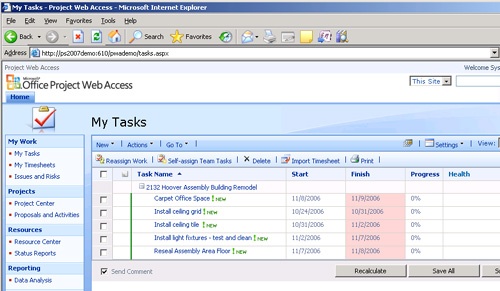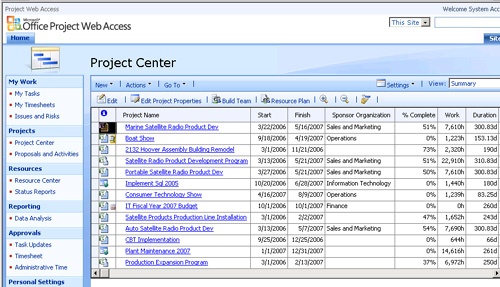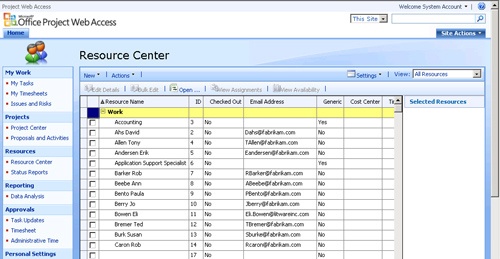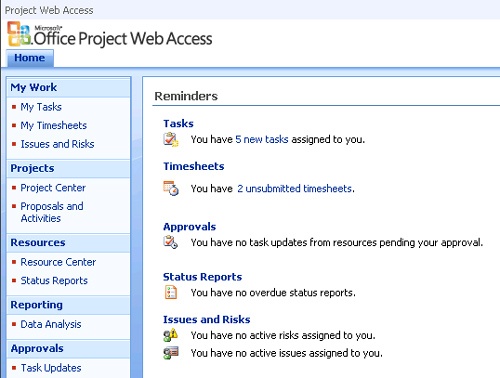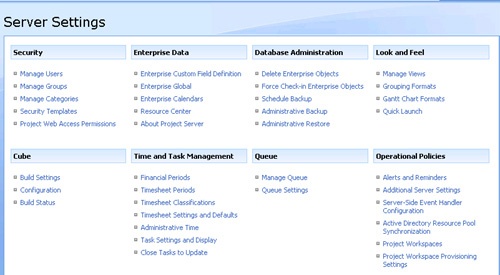Enterprise project management provides the means for dynamic project workgroup collaboration and project management throughout an entire organization.
Through the use of Microsoft Office Project Server 2007 working closely with Microsoft Office Project Professional 2007 and Microsoft Office Project Web Access, your organization has the capacity to set up powerful and fully customizable enterprise project management (EPM) functionality.
Using the Office Project Server 2007 EPM solution, all levels of project management information can be processed, stored, and viewed. Here are some examples of how various members of an organization might use tools within Project Server:
The team member might use her task page to review current tasks (see Figure 20-1).
The resource manager might perform a search for resources with specific skills and availability for possible use in an upcoming project.
The project manager might collect and collate status reports for one of his projects and then generate a report for a meeting with stakeholders in the morning.
The vice president of business development might analyze all the projects in a given portfolio to determine whether additional programs of this type are advantageous to the organization (see Figure 20-2).
Project Server facilitates communication of task assignments and actual progress among members of a project team, using Office Project Web Access as the Web-based interface. Hundreds, even thousands, of projects can be managed in a consistent manner throughout an organization. Microsoft Project elements such as views, toolbars, fields, and macros can be customized for the organization and standardized across all projects.
In addition, information about thousands of resources can be managed in Project Server. Resources and their associated skill, cost, and availability information can be built into a common and interactive enterprise resource pool from which all project managers can build their project teams. Team leads and resource managers can delegate tasks and manage resources as needed to accomplish the goals of the project and keep the project manager well-informed.
Because Project Web Access is an application of Windows SharePoint Services 3.0, the infrastructure is already in place for workgroup document check-in and checkout, issues tracking, and risk management.
Executives and other managing stakeholders can use Project Web Access to efficiently view and report on the portfolios of projects that make up a program or organizational initiative. They can do high-level modeling of analyses of tasks, resources, and costs across multiple projects and programs, including proposed projects.
Also available is the new Microsoft Office Project Portfolio Server 2007. Along with the companion Microsoft Office Project Portfolio Web Access, this product integrates with Project Server 2007 to provide a complete project portfolio management solution as part of your enterprise project management. It includes tools to help organizations identify, select, and manage portfolios in line with their business strategy.
Project Server 2007 has been re-architected to provide enhanced enterprise project management capabilities for managing complex programs and project portfolios with a large-scale globally distributed workforce. It is now easier for organizations to integrate their EPM solution with existing software and technologies having to do with human resources as well as organizational processes and policies. The new structure also provides for performance enhancements and other efficiencies.
Given the nature of project workgroups and enterprise project management, a variety of roles are played in project management, as follows:
Project manager. The traditional user of Microsoft Office Project, the project manager is still the hub around which all other roles revolve. The project manager primarily uses Office Project Professional 2007, but also typically uses Project Web Access as well. The project manager builds and adjusts the project, assigns resources, tracks progress, responds to changes, mitigates risks, and communicates progress throughout the project’s life cycle (see Figure 20-3).
Resource manager. Although the project manager often plays the role of the resource manager, Project Web Access makes it easy for a separate resource manager to work with the project manager to assign tasks to the right people. The resource manager uses Project Web Access with special resource-related privileges. The resource manager can manage data about users in the enterprise resource pool, review timesheets, and create resource-related views (see Figure 20-4).
Team lead. A team member carrying out a set of project tasks can also be assigned to lead responsibilities for a small group of other team members. The team lead uses Project Web Access to manage both responsibilities.
Team member. Actually completing the tasks that contribute to the project’s goal, team members implement the work of the project. Team members use Project Web Access to review, create, and update tasks and to see details of the project as a whole. Team members also use Project Web Access to enter and submit timesheet information regarding actual progress on assignments (see Figure 20-5).
Proposal reviewer. Typically one of the managing stakeholders, the proposal reviewer is responsible for reviewing proposals submitted through Project Web Access. By viewing data about existing projects, running reports, analyzing resource availability, examining cost projections, and so on, the proposal reviewer can examine proposed projects and determine whether they are in line with the organization’s strategic goals and worthy of pursuing.
Portfolio manager. The portfolio manager oversees the priorities and resource allocation for entire groups of projects. The portfolio manager can review information and run reports about all current and proposed projects and also create new proposals. This individual can also set up custom views, fields, and calendars for the entire enterprise.
Executive. Upper management, customers, or other managing stakeholders provide high-level direction for and support of a project, a portfolio of projects, or an entire program. These executives can keep an eye on progress of milestones, deliverables, costs, and other concerns through the use of specialized views in Project Web Access. They can also compare aspects of multiple projects against each other for sophisticated modeling or analysis leading to informed decisions for the organization.
Project server administrator. The project server administrator configures Project Server and Project Web Access to implement the features and permissions needed by the organization (see Figure 20-6). The administrator works mostly in Project Web Access and occasionally in Project Professional.
Although these roles are distinct, it’s entirely possible for one person to fulfill two or more overlapping roles and have the permissions in Project Server that reflect these multiple responsibilities.
This chapter provides a broad overview of the Project Server workgroup collaboration and enterprise project management solution, providing the context for who is involved and how all the pieces work together. Succeeding chapters are designed for specific audiences who work with aspects of Project Server in their specialized ways according to their role in the organization. These chapters and their intended audiences are as follows:
Chapter 21, is written for the project server administrator. The chapter presents general guidelines on configuring and tailoring Project Server and Project Web Access for enterprise project management in a specific organization. This chapter also includes instructions for typical system administrator duties such as adding new users and setting user permissions. Creation of customized elements for standardization is covered, as is setup for the enterprise resource pool, timesheets, and reports. Chapter 21 can also be reviewed by project managers who want a clearer picture of capabilities that are implemented by the administrator.
Chapter 22, is the project manager’s chapter. It details processes for creating an enterprise project, either from scratch or from an existing local project. It also discusses how to create a proposed project and activity plan. Building the project team from the enterprise resource pool is covered, as are details for team collaboration from the project manager’s standpoint.
Chapter 23, is the chapter designed for the team member, team lead, and resource manager, who all work in Project Web Access. The chapter includes information on accepting and creating new task assignments, reporting on assignment progress, and viewing the overall project picture. Information on building project teams and reassigning tasks is for team leads and resource managers.
Chapter 24, is directed at the executive or other managing stakeholder who wants to review high-level project and resource information. Information about using the Cube Builder for portfolio analysis is included in this chapter.

